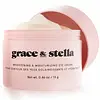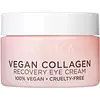What's inside
What's inside
 Key Ingredients
Key Ingredients

 Benefits
Benefits

 Concerns
Concerns

 Ingredients Side-by-side
Ingredients Side-by-side

Water
Skin ConditioningNiacinamide
SmoothingCaprylic/Capric Triglyceride
MaskingGlycerin
HumectantCetyl Alcohol
EmollientGlyceryl Stearate Citrate
EmollientCetearyl Olivate
Sorbitan Olivate
EmulsifyingPrunus Persica Kernel Extract
MoisturisingHamamelis Virginiana Extract
AntiseborrhoeicArnica Montana Flower Extract
MaskingAchillea Millefolium Extract
CleansingCamellia Sinensis Leaf Extract
AntimicrobialAesculus Hippocastanum Seed Extract
Skin ConditioningCaffeine
Skin ConditioningPotassium Sorbate
PreservativeTocopheryl Acetate
AntioxidantPotassium Cetyl Phosphate
EmulsifyingGlyceryl Stearate
EmollientPinus Pinaster Bark Extract
AntioxidantZinc Oxide
Cosmetic ColorantTriethoxycaprylylsilane
Ascorbyl Palmitate
AntioxidantSodium Hyaluronate
HumectantGlycyrrhiza Glabra Root Extract
BleachingEthylhexylglycerin
Skin ConditioningPhenoxyethanol
PreservativeWater, Niacinamide, Caprylic/Capric Triglyceride, Glycerin, Cetyl Alcohol, Glyceryl Stearate Citrate, Cetearyl Olivate, Sorbitan Olivate, Prunus Persica Kernel Extract, Hamamelis Virginiana Extract, Arnica Montana Flower Extract, Achillea Millefolium Extract, Camellia Sinensis Leaf Extract, Aesculus Hippocastanum Seed Extract, Caffeine, Potassium Sorbate, Tocopheryl Acetate, Potassium Cetyl Phosphate, Glyceryl Stearate, Pinus Pinaster Bark Extract, Zinc Oxide, Triethoxycaprylylsilane, Ascorbyl Palmitate, Sodium Hyaluronate, Glycyrrhiza Glabra Root Extract, Ethylhexylglycerin, Phenoxyethanol
Water
Skin ConditioningCetearyl Olivate
Caprylic/Capric Triglyceride
MaskingCetearyl Alcohol
EmollientGlycerin
HumectantSorbitan Olivate
EmulsifyingGlyceryl Caprylate
EmollientGlyceryl Stearate Se
EmulsifyingSr-Hydrozoan Polypeptide-1
HumectantChamomilla Recutita Flower Extract
MaskingCalendula Officinalis Flower Extract
MaskingCitrus Aurantium Dulcis Flower Extract
Skin ConditioningRosmarinus Officinalis Leaf Extract
AntimicrobialHydrolyzed Brassica Napus Seedcake Extract
Skin ConditioningJasminum Officinale Flower Extract
MaskingArnica Montana Flower Extract
MaskingLeuconostoc/Radish Root Ferment Filtrate
AntimicrobialCamellia Oleifera Seed Oil
Skin ConditioningHydrolyzed Jojoba Esters
Skin ConditioningCaffeine
Skin ConditioningAllantoin
Skin ConditioningPanthenol
Skin ConditioningSodium Hyaluronate
HumectantTocopherol
AntioxidantQuartz
AbrasiveOpuntia Ficus-Indica Seed Oil
EmollientArginine
MaskingBentonite
AbsorbentCoconut Alkanes
EmollientCoco-Caprylate/Caprate
EmollientCetyl Esters
EmollientStearic Acid
CleansingCetearyl Glucoside
EmulsifyingXanthan Gum
EmulsifyingMaltodextrin
AbsorbentGlucose
HumectantPhenoxyethanol
PreservativePotassium Sorbate
PreservativeSodium Benzoate
MaskingWater, Cetearyl Olivate, Caprylic/Capric Triglyceride, Cetearyl Alcohol, Glycerin, Sorbitan Olivate, Glyceryl Caprylate, Glyceryl Stearate Se, Sr-Hydrozoan Polypeptide-1, Chamomilla Recutita Flower Extract, Calendula Officinalis Flower Extract, Citrus Aurantium Dulcis Flower Extract, Rosmarinus Officinalis Leaf Extract, Hydrolyzed Brassica Napus Seedcake Extract, Jasminum Officinale Flower Extract, Arnica Montana Flower Extract, Leuconostoc/Radish Root Ferment Filtrate, Camellia Oleifera Seed Oil, Hydrolyzed Jojoba Esters, Caffeine, Allantoin, Panthenol, Sodium Hyaluronate, Tocopherol, Quartz, Opuntia Ficus-Indica Seed Oil, Arginine, Bentonite, Coconut Alkanes, Coco-Caprylate/Caprate, Cetyl Esters, Stearic Acid, Cetearyl Glucoside, Xanthan Gum, Maltodextrin, Glucose, Phenoxyethanol, Potassium Sorbate, Sodium Benzoate
Ingredients Explained
These ingredients are found in both products.
Ingredients higher up in an ingredient list are typically present in a larger amount.
Arnica Montana Flower is more commonly known as Wolf's Bane. While this flower has been used in traditional medicine, its skin benefits are in question.
The FDA considers Wolf's Bane to be an unsafe herb. They advise against taking it orally or applying it to broken skin.
Wolf's Bane has been said to have anti-inflammatory properties. However, studies are conflicting about whether this is true.
According to the Final report on the safety assessment of Arnica montana, this plant has not been found to cause dermal irritation.
This flower contains numerous fatty acids such as palmitic, linoleic, myristic, and linolenic acids. The presence and amount of fatty acids depends on where the flower is harvested.
Like other flowers, this ingredient has a natural fragrance. It can also be used to mask, or cover, the unpleasant scents from other ingredients.
Learn more about Arnica Montana Flower ExtractCaffeine is most associated with coffee, tea, and cacao. In skincare, it helps with calming inflammation and is rich in antioxidants.
While caffeine is used to treat cellulite and and dark circles, further studies are needed to prove this. It has been believed to help with these skin conditions due to its ability to dilate blood vessels and increase blood flow.
Some studies are looking into caffeine's ability to protect against UV rays.
Learn more about CaffeineThis ingredient is an emollient, solvent, and texture enhancer. It is considered a skin-softener by helping the skin prevent moisture loss.
It helps thicken a product's formula and makes it easier to spread by dissolving clumping compounds.
Caprylic Triglyceride is made by combining glycerin with coconut oil, forming a clear liquid.
While there is an assumption Caprylic Triglyceride can clog pores due to it being derived from coconut oil, there is no research supporting this.
Learn more about Caprylic/Capric TriglycerideCetearyl Olivate is an emulsifier and texture enhancer. It is derived from the fatty acids of olive oil and Cetearyl alcohol, and is biodegradable.
As an emulsifier, it is used to prevent oils and waters from separating. It can also
Manufacturers use the name Olivem 1000. This ingredient has been found to preserve the natural microbiome of skin. Having a healthy microbiome helps keep our skin healthy and protects against harmful bacteria. This ingredient is grouped with Sorbitan Olivate under the name Olivem 1000.
Learn more about Cetearyl OlivateGlycerin is already naturally found in your skin. It helps moisturize and protect your skin.
A study from 2016 found glycerin to be more effective as a humectant than AHAs and hyaluronic acid.
As a humectant, it helps the skin stay hydrated by pulling moisture to your skin. The low molecular weight of glycerin allows it to pull moisture into the deeper layers of your skin.
Hydrated skin improves your skin barrier; Your skin barrier helps protect against irritants and bacteria.
Glycerin has also been found to have antimicrobial and antiviral properties. Due to these properties, glycerin is often used in wound and burn treatments.
In cosmetics, glycerin is usually derived from plants such as soybean or palm. However, it can also be sourced from animals, such as tallow or animal fat.
This ingredient is organic, colorless, odorless, and non-toxic.
Glycerin is the name for this ingredient in American English. British English uses Glycerol/Glycerine.
Learn more about GlycerinPhenoxyethanol is a preservative that has germicide, antimicrobial, and aromatic properties. Studies show that phenoxyethanol can prevent microbial growth. By itself, it has a scent that is similar to that of a rose.
It's often used in formulations along with Caprylyl Glycol to preserve the shelf life of products.
Potassium Sorbate is a preservative used to prevent yeast and mold in products. It is commonly found in both cosmetic and food products.
This ingredient comes from potassium salt derived from sorbic acid. Sorbic acid is a natural antibiotic and effective against fungus.
Both potassium sorbate and sorbic acid can be found in baked goods, cheeses, dried meats, dried fruit, ice cream, pickles, wine, yogurt, and more.
You'll often find this ingredient used with other preservatives.
Learn more about Potassium SorbateSodium Hyaluronate is hyaluronic acid's salt form. It is commonly derived from the sodium salt of hyaluronic acid.
Like hyaluronic acid, it is great at holding water and acts as a humectant. This makes it a great skin hydrating ingredient.
Sodium Hyaluronate is naturally occurring in our bodies and is mostly found in eye fluid and joints.
These are some other common types of Hyaluronic Acid:
Learn more about Sodium HyaluronateSorbitan Olivate is created from the fatty acids in olive oil and sorbitol.
This ingredient is an oil in water emulsifier. It helps stabilize a product by preventing oils and waters from separating. Sorbitan Olivate also helps hydrate the skin.
Manufacturers sell sorbitan olivate under the name OliveM 1000. OliveM 1000 a multifunctional ingredient. It is self-emulsifying. According to a manufacturer, OliveM 1000 does not disrupt natural skin biome.
Due to its olive oil base, this ingredient may not be fungal-acne safe.
Learn more about Sorbitan OlivateWater. It's the most common cosmetic ingredient of all. You'll usually see it at the top of ingredient lists, meaning that it makes up the largest part of the product.
So why is it so popular? Water most often acts as a solvent - this means that it helps dissolve other ingredients into the formulation.
You'll also recognize water as that liquid we all need to stay alive. If you see this, drink a glass of water. Stay hydrated!
Learn more about Water